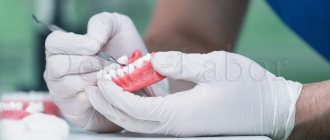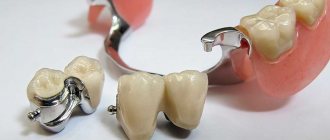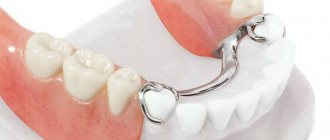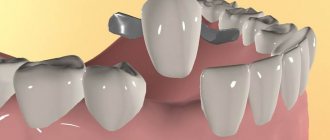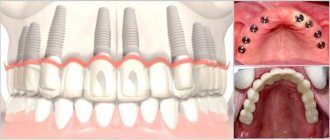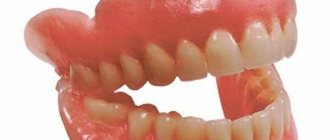Design features
Consists of artificial gums and teeth. The main retaining components are locking fasteners located at the base of the removable segment and on the surface of the non-removable section of the combined structure. In complex clinical situations, magnetic clamps with additional mechanical devices are used - telescopic crowns, push-button/rail fasteners. Made from metal, acrylic, nylon. The process of prosthetics includes two stages: preparation of the preserved fragments/organs, during which the doctor fixes frame components in the root stump, and the actual manufacture of the product. When applying a finished restoration, the boundaries must be corrected and the quality of the closing valve must be checked.
Example two
The same restoration method was successfully used in the case of an 80-year-old woman who complained that her lower teeth were severely worn. She had four mandibular implants 15 years ago, and her new mandibular prosthesis has been functioning perfectly for eight years.
It was a hybrid design with a gold axle and acrylic gums and teeth. She noted that the teeth had been used for years and was now unhappy with her appearance. Clinical examination revealed significant tooth wear at the bottom of the denture (Figures 13 and 14). Place opposite the upper arc. The worn prosthesis was successfully repaired using the same method as in the first case (Fig. 15 and 16).
Rice. 13 and 14. Implant before treatment, showing wear on the bottom of the acrylic teeth
Rice. 15 and 16. Restored prosthesis in place
Back to contents
Indications
Cover dentures can be complete or partial, depending on the type of edentia (absolute/fragmental), the dentist establishes a specific model:
- the presence of single standing organs or their elements. When the bone is thinned up to 50% of the root length, spherical metal attachments are used, with atrophy of 50% - telescopic crowns, involution of more than 50% is an indication for magnetic fixators;
- unfavorable prognosis for the use of removable restorations with sharp involution of the alveolar processes, pronounced gag reflex, xerostomia;
- increased periodontal abrasion in the working area.
Contraindications are: diabetes mellitus, blood and heart pathologies, dysfunction of the endocrine system, diseases of the central nervous system, poor oral hygiene, the presence of impassable canals, inflammatory changes in the root tissues of molars that are not subject to therapy.
How do covering dentures differ from removable dentures?
It’s easy to get confused in the concepts here, so let’s clarify that both types are removable. At least, that is what is commonly believed.
But in the classical view, coverings always have a strong support - teeth or implants. And traditional removable ones, especially with complete edentia, are fixed only on the gums. Although it is worth noting that in fact, even ordinary removable dentures have recently begun to be called overlays - this is argued by the fact that such structures also cover. Just not teeth or implants, but gums.
DENTAL PROSTHESIS ON 6 IMPLANTS - 290,000 rub.
The price includes all manipulations for installing Osstem implants (South Korea), manufacturing, installing and fitting the prosthesis, including anesthesia and diagnostics.
Save RUB 30,000. >> Call now or request a call
Opening hours: 24 hours a day - seven days a week
Installation options
After consultation and examination, the optimal method of carrying out the procedure is selected, taking into account the current state of the prosthetic bed: the pliability of the mucous membrane, the degree of atrophy of the alveolar processes, the presence of bone protrusions, the shape and condition of single teeth/roots (quality of filling, absence/presence of convergence, response to tapping) :
- on a natural frame. When installing a covering prosthesis, rational use of the remaining living elements should be a priority. To preserve them, the following are practiced: amputation (removal of one branch of a multi-root unit) and separation (dissection of the tooth into segments in the inflammatory area). This allows the roots to be used as the basis for restoration. An additional plus: the vertical transmission of pressure during chewing reduces the load on the mucous membrane, without causing a feeling of discomfort and shortening the adaptation period;
- on implants. For jaw prosthetics without teeth, their use is considered the best and most accessible method, due to the high percentage of clinical success, aesthetic effect and improved quality of life and chewing. Planning of orthopedic/surgical treatment protocols using this technique should take place after a thorough X-ray diagnosis in order to minimize the risks of postoperative complications and rejection of artificial frames.
Introduction
This article describes a method for restoring fixed objects consisting of a metal base with acrylic or composite rubber covered gums and teeth.
These repair tissues are called by various names in the literature, including:
- hybrid implant prosthetics;
- partial denture supported by implants;
- complete denture supported by implants;
- fixed bone-anchor prosthesis;
- fixed denture (1,2).
They have been used successfully for many years to completely restore the arch of dental implants in edentulous patients.
Recent systematic reviews over five years have shown implant survival rates in the region of 87-100%. Dentures - topic overview
These reconstructions, however, provide tangible evidence of the close connection between biology and technology, with prosthetic lifespans collectively ranging from 82-100%, according to studies conducted over 10 years.
One of the most common technical complications is the breakdown or wear of acrylic or composite material, the parameters of which change up to 25.3% over five years.
A metal frame, on the other hand, has little wear and tear, but the cost of such a fixed denture is high, so all techniques in which the metal frame can be repaired, but not reinstalled, are welcome.
This article describes a technique our team often uses to restore fixed dentures where teeth have become worn or damaged. Two clinical examples are given as examples.
Back to contents
Prices for installing overdentures
| Code no. | NAME OF PROCEDURES | Unit of measurement | Cost, rub. |
| 702 | Taking an impression with alginate mass | 1 500,00 | |
| 706 | Making a custom spoon | 4 500,00 | |
| 707 | Making a bite template | 3 000,00 | |
| 752 | Complete removable denture on a bar structure with attachments | 190 000,00 | |
| 757 | Complete removable monomer-free prosthesis “Quadrotti” | 60 000,00 | |
| 762 | Complete removable denture reinforced with mesh | 65 000,00 |
The final price tag for a service in our dental clinic starts from 12,000 rubles and consists of the number of prosthetic organs, the material of the system, and the method of forming the base. If a natural base is used, preliminary tissue preparation may be required: removal of high mucosal frenulums and cords, periodontal pockets, gingivotomy to lengthen the crown. When resting on dental implants, their number is taken into account - 6, 4 or 2. The more artificial support units are needed, the more expensive the product will be.
* The prices indicated on the website are not a public offer. The exact cost of treatment can only be determined at an appointment with a doctor.
Prices for treatment in Moscow full price list
Share on social media networks:
Briefly about the technology of taking dental impressions with silicone
The dentist loads the required amount of soft silicone into a special, sized “spoon” and presses this mass to the patient’s teeth. In this case, the mass “embraces” all the teeth and jawbones of a person and hardens within about three minutes. The mass can press on the palate and get into the throat. And this is not always pleasant and convenient. Yes, nothing terrible happens, but discomfort may be present when taking impressions.
After the silicone has hardened in the mouth, it is removed, sterilized and sent to a dental laboratory. In the laboratory, a dental technician pours a special plaster into the impression. The plaster hardens. Then the plaster is removed from the impression and a plaster model is obtained - an exact copy of the patient’s teeth and bite! That's what it all started for! It is the model that is studied for diagnostic purposes. And it is on models that crowns, veneers and other devices or dentures are made.
How many models can be made from one cast? Best one! Because when removing a model from a cast, the cast most often breaks. The plaster model is also not durable. Plaster can chip and wear off. You need space to store plaster models! For example, there are 35 thousand patients in the Family Dental database. Imagine how much storage is needed to store models for all patients! But for some patients it is necessary to store several models, for example, before and after bite correction!
We recommend that you read
Plate prosthesis
Ceramic crowns
Zirconium crowns
Dental restoration
What stages are included in prosthetics?
- Stage 1 – diagnosis: before implantation, tests are taken and a computed tomography scan of the jaw is performed. In other cases, doctors often make do with a targeted image, but CT is more informative,
- stage 2 – sanitation of the oral cavity: caries and pulpitis are treated here, the remaining roots are prepared, and ultrasonic air-abrasive cleaning is carried out. If necessary, the dentist cleans the gum pockets from pathological contents (this is called curettage). Also at this stage, you can do gingivotomy or gum surgery, frenuloplasty, remove diseased teeth,
- stage 3 – taking impressions and other parameters to create a model,
- stage 4 – implantation (if necessary): here the required number of implants is implanted,
- stage 5 – fitting and modification of the prosthesis,
- Stage 6 – final fixation of the finished product and training the patient in the rules of care.
Don't know what type of prosthetics to choose?
We will help in the selection, advise where to read more information and compare types of prosthetics.
Consultation with an orthopedic doctor in Moscow clinics is free! Call now or request a call
Working hours: from 9:00 to 21:00 - seven days a week
Causes of breakdowns
Dentures are made from fairly durable materials, but cracks and chips can still form on them.
This happens for the following reasons:
- the service life of the product has expired;
- the material is not flexible enough and cannot withstand the load of chewing;
- During casting, polycondensation occurred, that is, a large amount of moisture evaporated from the plastic mass;
- saliva remained in the ingot and damaged the casting;
- insufficient formation of the constituent components of the cast;
- poor fitting;
- poor fit of the structure to the gums, which increased the load on the device;
- deviation from manufacturing technology.
There is no need to rush to throw away a broken device; in most cases it can be repaired. The ability to glue an orthopedic structure at home depends on the type of failure.
You will need to contact an orthopedist in the following cases:
- the crown broke;
- the plastic lining has broken off - specific materials will be required for repairs;
- the ceramic lining on a metal-ceramic prosthesis fell off;
- The soldering joints of the steel structure had crumbled.
Restoring a fixed bridge prosthesis at home is a fantasy. Fixed dentures can only be repaired by removing them from the mouth.
It is theoretically possible to repair metal-ceramic fixed dentures directly in the mouth, but the result will only last for a few hours. The broken structure will have to be removed and new crowns soldered to it.
Important! Don’t even try to solder crowns directly in your mouth at home. You cannot try to reattach the structure to your teeth at home using any available adhesives.
You cannot try to reattach the structure to your teeth at home using any available adhesives.
The fact is that the bridge prosthesis flies off the tooth when the filling material underneath dissolves and caries begins.
Before placing the structure in place, the doctor must examine the tooth and, if necessary, refill it. Without this, the tooth will quickly rot right under the crown.
Video:
Pharmacies sell glue for repairing orthopedic devices. It is not as high quality as professional cement, but with its help it is quite possible to fix a crown on a tooth or in a device for a short time at home.
This time should be spent making an appointment with an orthopedist and waiting for your turn.
If you use unsuitable materials for gluing a bridge (and at home there is simply nowhere to get suitable ones), you can not only get food poisoning, but also harm your teeth and gums.
Tooth softening and gingivitis are only a small part of the undesirable consequences of self-fixation of a fixed prosthesis on the teeth.
Causes and types of prosthesis failures
There are many reasons for failure of artificial structures:
- Dentist mistakes during preparatory work. Incorrectly taken dental impressions lead to the production of an unsuitable denture.
- If the dental technician used a low-quality metal alloy or acrylic plastic (in which air bubbles are visible), the denture will most likely not last long.
- Errors made during laboratory manufacturing. The slightest mistake will lead to incorrect distribution of the chewing load on the teeth or a loose fit of the structure.
- Carelessness in care and wearing. Fall, use of unsuitable solution, poor or irregular hygiene, improper fixation or removal of the structure.
- Physiological changes in the jaw. Over time, changes may occur in the structure of the alveolar processes, which will lead to a loose fit of the base.
- Wear or end of service life. Each material has a certain service life. After its expiration, the quality characteristics of the materials decrease, the prosthesis becomes fragile and unreliable.
Main types of breakdowns:
- failure of the fixation system;
- fracture of acrylic or nylon base;
- cracks and chips on crowns;
- loss of artificial teeth;
- peeling of material or component;
- unexplained discomfort while wearing;
- color change.
How to store it correctly
It is also important to pay attention to the proper storage of devices during sleep. Each prosthesis has its own recommendations. But general storage rules include placing the structure in a special disinfecting cleaning solution during sleep.
But general storage rules include placing the structure in a special disinfecting cleaning solution during sleep.
With the help of a disinfectant, bacteria, plaque, and food particles are removed, ensuring comfortable wearing of the device in the future. Before starting to use dentures, it is better to consult with a specialist regarding storage issues.
When repairs are needed
Despite the high strength of the materials used in the manufacture of dentures, over time the products can still break. The wearer of such a design often has to deal with such a procedure as repairing dentures, and often urgently.
Broken denture
The main reasons that may lead to the need for repairs include:
- changing the color of the structure;
- the occurrence of unpleasant sensations or discomfort when wearing prostheses, which the patient has not encountered before;
- detachment of a small part of the prosthesis, detachment or chipping;
- mechanical damage that can occur for various reasons.
Failures of removable laminar dentures occur for various reasons.
If a prosthesis breaks down, it is advisable to immediately seek help from a specialist who was directly involved in the manufacture of the product and its installation. Only in this case will all the necessary repair conditions be met. After a thorough examination, the doctor will be able to analyze the damage to the prosthesis and announce the cost of restoring the prosthesis (if this is even possible in a particular case).
If you compare repairing artificial teeth with making new ones, it will certainly cost much less. But in rare cases, defects may arise that even a qualified specialist cannot cope with, let alone repair at home.
Nothing is insured against damage or defects, so in some cases full or partial denture repairs may be required.
Cracks
The most common requests for urgent repair of a prosthesis are related to cracks in the structure. Therefore, it makes sense to immediately consult a doctor in order to avoid the worst-case scenario of further developments, when the product splits into several parts. This often happens, for example, with removable plastic dentures.
Chips and breaks
Patients with chips on artificial crowns often turn to dentistry for denture repair. And this is absolutely correct! The sharp edges of broken crowns can injure the oral cavity, so a damaged denture definitely needs urgent repair. You should also contact the clinic if a fragment of the outer layer breaks off from the metal-ceramic crown. Such repairs will not take much time, and the doctor will most likely restore the damaged crown using composite materials. However, in some cases, the artificial crown may even fall out of the base.
Damage to fastenings
Also, fastenings of various types of prostheses are susceptible to breakage: clasps, locks or telescopic fixation elements.
Baths and mouth rinses
For owners of removable dentures, an ultrasonic bath is offered, which allows you to thoroughly clean the device. Such a device will eliminate the need to visit a doctor for professional teeth cleaning, since a similar procedure is carried out at home. This bath is a reservoir of liquid into which a removable denture is placed. Ultrasonic waves pass through the liquid and tiny bubbles are formed. These vacuum bubbles wash away plaque, penetrate pores, and remove pigments. After cleaning, the structure is polished and dried on a napkin.
We must not forget about the importance of caring for the mucous membrane, because if you only clean the denture, it will be useless and inflammation will appear under the structure
What rinses to use:
- hygiene products Lakalut, Splat, Forest Balm, Asepta;
- antiseptic solutions Chlorhexidine, potassium permanganate;
- decoctions and infusions of medicinal herbs.
This will allow you to keep your mouth clean throughout the day and remove food particles that get under the denture. If you do not rinse your mouth after eating, by the end of the day an unpleasant odor will appear, a piece of food will begin to rot, which will lead to inflammation. For the same reason, there may be complaints of pain when chewing and pressing on the prosthesis.
The process of gluing the prosthesis, video
If a patient has a broken or cracked removable or fixed denture, it can be restored independently. There are many videos on the Internet demonstrating this procedure. Restoration at home is possible with minor defects: the clasp comes out, the appearance of a crack or chip, or the decementing of the crown. All operations are carried out after removing the structure from the mouth. Restoration is performed according to the following algorithm:
- Combine the parts of the product to see if all the parts are in place.
- If the structure has burst in half, the sharp edges must be cut down and cleaned of dust.
- Wash the denture thoroughly, removing the previous fixative, food debris, etc. For this work, you will need a small brush, as well as a solution obtained from special tablets that disintegrate in water.
- Dry the structure until the moisture completely disappears. The presence of water has a bad effect on the clutch.
- Regardless of which glue was chosen for repair, it is applied in small specks.
- The parts must be glued by pressing the product elements tightly against each other, without distortions. Excess cement, wax or cream must be removed.
- The structure cannot be put on until the adhesive composition has completely dried.
- The procedure is completed by washing the prosthesis in soapy water.
If prosthetics was performed with a crown, it is prepared for self-installation according to the algorithm described above. After spot-applying the glue, it must be secured to the tooth in its original position. Then the jaws are squeezed tightly for 1 minute - this will allow the glue to fix the product.
After repair, the prosthesis needs to be thoroughly polished to prevent injury to soft tissues when speaking and chewing, but this is only done in a laboratory. In addition, a self-repaired prosthesis will not last long - you should visit a doctor as soon as possible. Pharmacy glue, with careful use of the prosthesis, avoidance of eating solid foods and gentle brushing of the teeth, will ensure a two-week service life of the structure.
Gluing the product in a workshop will cost 15% of the cost of a new prosthesis. In large cities, laboratory repairs take 1–2 hours, so patients can decide for themselves what is more convenient for them.
